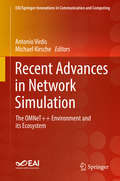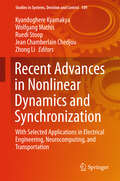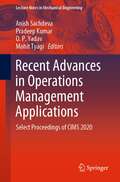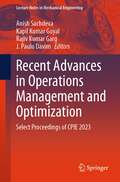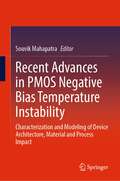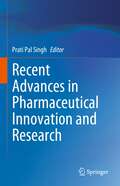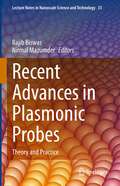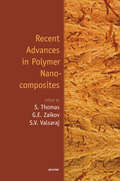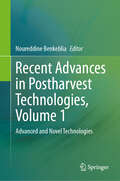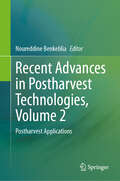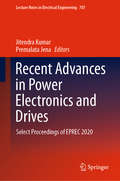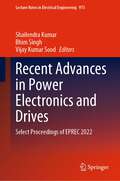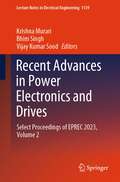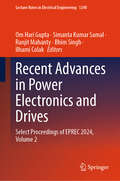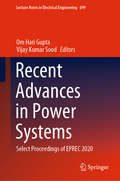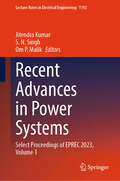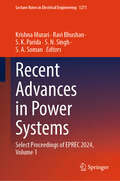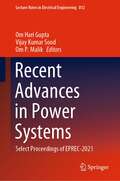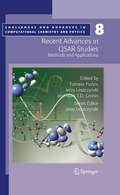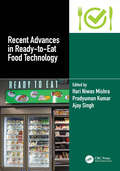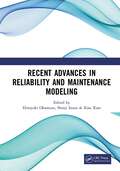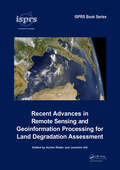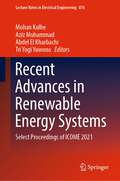- Table View
- List View
Recent Advances in Network Simulation: The OMNeT++ Environment and its Ecosystem (EAI/Springer Innovations in Communication and Computing)
by Antonio Virdis Michael KirscheThis book provides a comprehensive introduction to the OMNeT++ simulation environment and an overview of its ecosystem of ever-growing frameworks, which provide simulation models for diverse communication systems, protocols, and standards. The book covers the most recent advances of the three key points in the OMNeT++ environment: (1) The latest features that are being added to OMNeT++ itself, including improvements in the visualization options, in data processing, etc. (2) A comprehensive description of the current state of development and the work in progress of the main simulation frameworks, covering several aspects of communication such as vehicular, cellular, and sensor networks. (3) The latest advances and novel developments coming from a large research community. The presentation is guided through use cases and examples, always keeping in mind the practical and research purposes of the simulation process. Includes an introduction to the OMNeT++ simulation framework and its main features;Gives a comprehensive overview of ongoing research topics that exploits OMNeT++ as the simulation environment;Provides examples and uses cases focusing on the practical aspects of simulation.
Recent Advances in Nonlinear Dynamics and Synchronization
by Ruedi Stoop Zhong Li Kyandoghere Kyamakya Wolfgang Mathis Jean Chamberlain ChedjouIn essence, the dynamics of real world systems (i. e. engineered systems, natural systems, social systesms, etc. ) is nonlinear. The analysis of this nonlinear character is generally performed through both observational and modeling processes aiming at deriving appropriate models (mathematical, logical, graphical, etc. ) to simulate or mimic the spatiotemporal dynamics of the given systems. The complex intrinsic nature of these systems (i. e. nonlinearity and spatiotemporal dynamics) can lead to striking dynamical behaviors such as regular or irregular, stable or unstable, periodicity or multi-periodicity, torus or chaotic dynamics. The various potential applications of the knowledge about such dynamics in technical sciences (engineering) are being intensively demonstrated by diverse ongoing research activities worldwide. However, both the modeling and the control of the nonlinear dynamics in a range of systems is still not yet well-understood (e. g. system models with time varying coefficients, immune systems, swarm intelligent systems, chaotic and fractal systems, stochastic systems, self-organized systems, etc. ). This is due amongst others to the challenging task of establishing a precise and systematic fundamental or theoretical framework (e. g. methods and tools) to analyze, understand, explain and predict the nonlinear dynamical behavior of these systems, in some cases even in real-time. The full insight in systems' nonlinear dynamic behavior is generally achieved through approaches involving analytical, numerical and/or experimental methods.
Recent Advances in Operations Management Applications: Select Proceedings of CIMS 2020 (Lecture Notes in Mechanical Engineering)
by Pradeep Kumar Anish Sachdeva Mohit Tyagi O. P. YadavThis book presents the select proceedings of the International Conference on Industrial and Manufacturing Systems (CIMS 2020). It presents the current scenarios and future advancements in the domain of industrial engineering under context of optimum value. Various topics covered include optimisation and its applicability in the various areas of industrial engineering like selection of designing parameters and, decisions related to conditions of optimum process/operation parameters, facilities planning and management, transportation and supply chain management, quality engineering, reliability and maintenance, system optimization, product design and development, human factors and ergonomics, project management, service system and service management, waste management, sustainable manufacturing and operations, systems design, lean manufacturing, and performance measurement. This book will be useful for the students, researchers and professionals working in the area of industrial and production engineering.
Recent Advances in Operations Management and Optimization: Select Proceedings of CPIE 2023 (Lecture Notes in Mechanical Engineering)
by J. Paulo Davim Anish Sachdeva Rajiv Kumar Garg Kapil Kumar GoyalThe book presents the select proceedings of International Conference on Production and Industrial Engineering (CPIE) 2023. It covers the current and latest research methods for development and implementation of operation. Various topics covered include selection of designing parameters, decisions related to conditions of optimum process/operation parameters, facilities planning and management, transportation and supply chain management, quality engineering, reliability and maintenance, product design and development, human factors and ergonomics, project management, service system and service management, waste management, sustainable manufacturing, and operations. The book is useful for researchers and professionals working in manufacturing, industrial engineering, systems engineering, and production engineering.
Recent Advances in PMOS Negative Bias Temperature Instability: Characterization and Modeling of Device Architecture, Material and Process Impact
by Souvik MahapatraThis book covers advances in Negative Bias Temperature Instability (NBTI) and will prove useful to researchers and professionals in the semiconductor devices areas. NBTI continues to remain as an important reliability issue for CMOS transistors and circuits. Development of NBTI resilient technology relies on utilizing suitable stress conditions, artifact free measurements and accurate physics-based models for the reliable determination of degradation at end-of-life, as well as understanding the process, material and device architectural impacts. This book discusses: Ultra-fast measurements and modelling of parametric drift due to NBTI in different transistor architectures: planar bulk and FDSOI p-MOSFETs, p-FinFETs and GAA-SNS p-FETs, with Silicon and Silicon Germanium channels. BTI Analysis Tool (BAT), a comprehensive physics-based framework, to model the measured time kinetics of parametric drift during and after DC and AC stress, at different stress and recovery biases and temperature, as well as pulse duty cycle and frequency. The Reaction Diffusion (RD) model is used for generated interface traps, Transient Trap Occupancy Model (TTOM) for charge occupancy of the generated interface traps and their contribution, Activated Barrier Double Well Thermionic (ABDWT) model for hole trapping in pre-existing bulk gate insulator traps, and Reaction Diffusion Drift (RDD) model for bulk trap generation in the BAT framework; NBTI parametric drift is due to uncorrelated contributions from the trap generation (interface, bulk) and trapping processes. Analysis and modelling of Nitrogen incorporation into the gate insulator, Germanium incorporation into the channel, and mechanical stress effects due to changes in the transistor layout or device dimensions; similarities and differences of (100) surface dominated planar and GAA MOSFETs and (110) sidewall dominated FinFETs are analysed.
Recent Advances in Pharmaceutical Innovation and Research
by Prati Pal SinghThis book covers several important aspects of pharmaceutical research and innovations. It presents important topics on drug delivery, novel microsponge, nanocrystals, polymeric nanoparticles, peptide synthesis, biopharmaceuticals, pharmacodynamics, yeast flocculation, neuromodulators, innovative drug discovery, pharmacoinformatics, aminoquinoline, thiourea crystals for API synthesis, FDCs and formulations research, ayurveda and natural products, and innovations to militate anti-microbial resistance (AMR). A chapter is devoted to the applications of Artificial Intelligence and Machine Learning in diverse sectors of the pharmaceutical industry, including drug discovery and development, drug repurposing, and improving pharmaceutical productivity. The book also reviews the role of pharmacogenomics and pharmacogenetics in drug development and precision medicine. Further, the book presents an updated summary of recent advances in the fields of nanomedicines and nano-based drug delivery systems. This book is useful to pharmaceutical sciences students, researchers, educators, and professionals in the pharmaceutical industry to understand the intricacies of new drug research and innovations.
Recent Advances in Plasmonic Probes: Theory and Practice (Lecture Notes in Nanoscale Science and Technology #33)
by Nirmal Mazumder Rajib BiswasThis book gives a comprehensive overview of recent advancements in both theory and practical implementation of plasmonic probes. Encompassing multiple disciplines, the field of plasmonics provides a versatile and flexible platform for nanoscale sensing and imaging. Despite being a relatively young field, plasmonic probes have come a long way, with applications in chemical, biological, civil, and architectural fields as well as enabling many analytical schemes such as immunoassay, biomarkers, environmental indexing, and water quality sensing, to name but a few. The objective of the book is to present in-depth analysis of the theory and applications of novel probes based on plasmonics, with a broad selection of specially-invited chapters on the development, fabrication, functionalization, and implementation of plasmonic probes as well as their integration with current technologies and future outlook. This book is designed to cater to the needs of novice, seasoned researchers and practitioners in academia and industry, as well as medical and environmental fields.
Recent Advances in Polymer Chemical Physics: Contributions of the Russian Academy of Science
by Dusan C. PrevorsekThe Institute of Chemical Physics of the Russian Academy of Sciences has become one of the world's premiere centers for studies of polymeric materials; in use, during processing, and in harsh environments. The Institute's focus is on commercially available materials and their modifications to improve performance through advanced theoretical analysis and implementation of experimental results. Selected papers from the Institute have been incorporated into five sections-Stabilization and Degradation, Biochemistry , Photochemistry, Rheology and Flame Retardancy-and should provide invaluable background to producers of polymeric materials.
Recent Advances in Polymer Nanocomposites
by Gennady Zaikov Sabu Thomas ValsarajThis book is a collection of technical papers focusing on the preparation, characterization and application of polymer nanocomposites. The various chapters in the book are written by prominent researchers from industry, academia, and government/private research laboratories across the globe. Different techniques adopted for the preparation of nanoc
Recent Advances in Postharvest Technologies, Volume 1: Advanced and Novel Technologies
by Noureddine BenkebliaThe elapsing time from producer to consumer has significantly increased as a result of food marketing and trade globalization. Consequently, maintaining quality along the food value chain is becoming a significant challenge. Postharvest losses are considered a major component of food loss and waste in the supply chain from farmers to consumers, due to improper handling, storage, transport, preservation techniques and spoilage. Postharvest science aims to extend the shelf life of fresh and perishable commodities, and to reduce heavy losses, thereby contributing to food security. While significant progresses have been made in postharvest preservation and shelf-life extension, the continuous development of emerging technologies have changed our vision on postharvest science. Furthermore, recent advancements in molecular engineering of horticultural crops for quality improvement; the development of genomics, transcriptomics, proteomics, and metabolomics have led to a better understanding of the physiology and the biochemistry of the senescence processes, resulting in better preservation and improved production of fresh crops. This two-volume work focuses on innovative technologies that extend and preserve shelf life of fruits and vegetables. Volume 1 offers a review on the state-of-the-art modern technologies in the postharvest filed. The accompanying Volume 1 explores advanced and novel technologies after harvest, particularly the application of nanotechnologies to packaging materials.
Recent Advances in Postharvest Technologies, Volume 2: Postharvest Applications
by Noureddine BenkebliaThe elapsing time from producer to consumer has significantly increased as a result of food marketing and trade globalization. Consequently, maintaining quality along the food value chain is becoming a significant challenge. Postharvest losses are considered a major component of food loss and waste in the supply chain from farmers to consumers, due to improper handling, storage, transport, preservation techniques and spoilage. Postharvest science aims to extend the shelf life of fresh and perishable commodities, and to reduce heavy losses, thereby contributing to food security. While significant progresses have been made in postharvest preservation and shelf-life extension, the continuous development of emerging technologies have changed our vision on postharvest science. Furthermore, recent advancements in molecular engineering of horticultural crops for quality improvement; the development of genomics, transcriptomics, proteomics, and metabolomics have led to a better understanding of the physiology and the biochemistry of the senescence processes, resulting in better preservation and improved production of fresh crops. This two-volume work focuses on innovative technologies that extend and preserve shelf life of fruits and vegetables. Volume 1 offers a review on the state of the art modern technologies in the postharvest filed. The accompanying Volume 2 explores advanced and novel technologies after harvest, particularly the application of nanotechnologies to packaging materials.
Recent Advances in Power Electronics and Drives: Select Proceedings of EPREC 2020 (Lecture Notes in Electrical Engineering #707)
by Jitendra Kumar Premalata JenaThis book presents select proceedings of the Electric Power and Renewable Energy Conference 2020 (EPREC-2020). It provides rigorous discussions, case studies, and recent developments in the emerging areas of power electronics, especially, power inverter and converter, electrical drives, regulated power supplies, operation of FACTS & HVDC, etc. The readers would be benefited in enhancing their knowledge and skills in these domain areas. The book will be a valuable reference for beginners, researchers, and professionals interested in advancements in power electronics and drives.
Recent Advances in Power Electronics and Drives: Select Proceedings of EPREC 2021 (Lecture Notes in Electrical Engineering #852)
by Bhim Singh Shailendra Kumar Arun Kumar SinghThis book contains select proceedings of EPREC-2021 with a focus on power electronics and drives. The book includes original research and case studies that present recent developments in power electronics focusing on power inverters and converters. The book also consists of research work on electrical drives, regulated power supplies, operation of FACTS & HVDC, etc. The book will be a valuable reference guide for beginners, researchers, and professionals interested in the advancements of power electronics and drives.
Recent Advances in Power Electronics and Drives: Select Proceedings of EPREC 2022 (Lecture Notes in Electrical Engineering #973)
by Bhim Singh Shailendra Kumar Vijay Kumar SoodThis book presents select proceedings of the Electric Power and Renewable Energy Conference 2022 (EPREC-2022). It provides rigorous discussions, case studies, and recent developments in the emerging areas of power electronics, especially power inverters and converter, electrical drives, regulated power supplies, operation of FACTS and HVDC, etc. The readers would be benefited from enhancing their knowledge and skills in these domain areas. The book is a valuable reference for beginners, researchers, and professionals interested in advancements in power electronics and drives.
Recent Advances in Power Electronics and Drives: Select Proceedings of EPREC 2023, Volume 2 (Lecture Notes in Electrical Engineering #1139)
by Bhim Singh Vijay Kumar Sood Krishna MurariThis book entitled “Recent Advances in Power Electronics and Drives - Select Proceedings of EPREC-2023 provides rigorous discussions, case studies, and recent developments in the emerging areas of power electronics, especially in power inverters and converters, electrical drives, regulated power supplies, electric vehicle and its charging infrastructure, etc. The readers would benefit from enhancing their knowledge and skills in the domain areas. Also, this book may help the readers in developing new and innovative ideas. The book can be a valuable reference for beginners, researchers, and professionals interested in advancements in power electronics and drives.
Recent Advances in Power Electronics and Drives: Select Proceedings of EPREC 2024, Volume 2 (Lecture Notes in Electrical Engineering #1240)
by Bhim Singh Om Hari Gupta Simanta Kumar Samal Ranjit Mahanty Ilhami ColakThis book entitled “Recent Advances in Power Electronics and Drives - select proceedings of EPREC-2024 provides the rigorous discussions, case studies, and recent developments in the emerging areas of power electronics, especially, power inverter and converter, electrical drives, regulated power supplies, electric vehicle and its charging infrastructure, etc. There are two main problems with the electric vehicle (EVs) technology, which are associated with the range anxiety, charging spot and time. These problems can be taken care of with having a good charging infrastructure, which provides ways to improve the environmental conditions and make sure to mitigate these issues. The same issues would be addressed via this book. The readers would be benefited in enhancing their knowledge and skills in the domain areas. Also, this book may help the readers in developing new and innovative ideas. The book can be a valuable reference for beginners, researchers, and professionals interested in advancements in power electronics and drives.
Recent Advances in Power Systems: Select Proceedings of EPREC 2020 (Lecture Notes in Electrical Engineering #699)
by Om Hari Gupta Vijay Kumar SoodThis book presents select proceedings of Electric Power and Renewable Energy Conference 2020 (EPREC 2020). This book provides rigorous discussions, case studies, and recent developments in the emerging areas of the power system, especially, renewable energy conversion systems, distributed generations, microgrid, smart grid, HVDC & FACTS, power system protection, etc. The readers would be benefited in terms of enhancing their knowledge and skills in the domain areas. The book will be a valuable reference for beginners, researchers, and professionals interested in developments in the power system.
Recent Advances in Power Systems: Select Proceedings of EPREC 2023, Volume 1 (Lecture Notes in Electrical Engineering #1192)
by Om P. Malik Jitendra Kumar S. N. SinghThis conference proceedings entitled “Recent Advances in Power Systems presents - select proceedings of EPREC-2023 provides the rigorous discussions, case studies, and recent developments in the emerging areas of power system, especially, policy issues - policies for distributed generation, sustainable energy, microgrid, smart grid, HVDC & FACTS, power quality, power system protection, etc. The readers would be benefitted in enhancing their knowledge and skills in the domain areas. The book can be a valuable reference for beginners, researchers, and professionals interested in developments in power system.
Recent Advances in Power Systems: Select Proceedings of EPREC 2024, Volume 1 (Lecture Notes in Electrical Engineering #1271)
by S. N. Singh Krishna Murari Ravi Bhushan S. K. Parida S. A. SomanThis conference proceedings, titled "Recent Advances in Power Systems: Select Proceedings of EPREC-2024," offers comprehensive discussions, case studies, and recent advancements in power systems, with a particular focus on policy matters such as policies for distributed generation, sustainable energy, microgrid, smart grid, HVDC & FACTS, power quality, and power system protection. The publication aims to enrich the knowledge and expertise of readers in the field, serving as a valuable reference for beginners, researchers, and professionals keen on exploring developments in power systems. Furthermore, the book has the potential to inspire the generation of novel and innovative ideas in this domain.
Recent Advances in Power Systems: Select Proceedings of EPREC-2021 (Lecture Notes in Electrical Engineering #812)
by Om P. Malik Om Hari Gupta Vijay Kumar SoodThis book contains selected proceedings of EPREC-2021 with a focus on power systems. The book includes original research and case studies that present recent developments in power systems, principally renewable energy conversion systems, distributed generations, microgrids, smart grid, HVDC & FACTS, power quality, power system protection, etc. The book will be a valuable reference guide for beginners, researchers, and professionals interested in advancements in power systems.
Recent Advances in QSAR Studies
by Jerzy Leszczynski Mark T. Cronin Tomasz PuzynThis book presents an interdisciplinary overview on the most recent advances in QSAR studies. The first part is handbook-esque and consists of a comprehensive review of QSAR methodology written by outstanding scientists and highly experienced lecturers. It focuses on methodology and new ideas, providing readers with an idea of recent trends and developments in each part of QSAR strategy (descriptors, methods of modelling, validation). The second part highlights the interdisciplinary aspects and new areas of QSAR modelling. It outlines the theoretical framework together with practical applications. The most optimal solutions (descriptors, mathematical/statistical methods, validation) in the individual areas of interest (environmental risk assessment, drug design, etc.) are also discussed in more detail. "Recent Advances in QSAR Studies: Methods and Applications" is targeted at scientists focussed on developing new methodologies as well as researchers engaged in trying to solve specific problems via QSAR.
Recent Advances in Ready-to-Eat Food Technology
by Ajay Singh Pradyuman Kumar Hari Niwas MishraReady-to-Eat (RTE) describes foods that need not be cooked, reheated, or otherwise prepared before consuming them. Recent Advances in Ready-to-Eat Food Technology covers all the aspects of RTE from statistics, method of production, mechanization, thermal and non-thermal processing, gluten-free, consumer behavior, control of foodborne illness and hygiene, packaging requirements, and improved functionalization to application of nanotechnology.Key Features: Covers the development of ready-to-eat products from meat, cereal, fruits, vegetables, dairy, and pulses Provides a global review of labeling and packaging for ready-to-eat products Discusses hygienic design and safety in the production and consumption, with an emphasis on pathogenicity issues Written by a team of well-recognized researchers who present the latest advances in RTE food product development, this book is of interest to industry professionals and academicians as well as to undergraduate students and postgraduate researchers.
Recent Advances in Reliability and Maintenance Modeling: Proceedings of the 11th Asia-Pacific International Symposium on Advanced Reliability and Maintenance Modeling (APARM 2024, Nagoya, Japan, 26-30 August 2024)
by Xiao Xiao Hiroyuki Okamura Shinji InoueRecent Advances in Reliability and Maintenance Modeling contains the papers presented at the 11th Asia-Pacific International Symposium on Advanced Reliability and Maintenance Modeling (APARM 2024, Nagoya, Japan, 26-30 August 2024). The contributions discuss and explore solutions to the various reliability challenges facing society. Reliability and maintenance is the technology required in various fields such as (but not limited to):- Power systems- Communication networks- Transportation- Cloud computing- Electronic systems- Buildings and infrastructure- Medical and healthcare- Aviation and railway systems.Recent Advances in Reliability and Maintenance Modeling is of interest to academics and professionals interested or involved in the above mentioned areas.
Recent Advances in Remote Sensing and Geoinformation Processing for Land Degradation Assessment
by Joachim Hill Achim RöderLand degradation and desertification are amongst the most severe threats to human welfare and the environment, as they affect the livelihoods of some 2 billion people in the worlds drylands, and they are directly connected to pressing global environmental problems, such as the loss of biological diversity or global climate change. Strategies to co
Recent Advances in Renewable Energy Systems: Select Proceedings of ICOME 2021 (Lecture Notes in Electrical Engineering #876)
by Mohan Kolhe Aziz Muhammad Abdel El Kharbachi Tri Yogi YuwonoThis book presents the select proceedings of 5th International Conference on Mechanical Engineering (ICOME 2021). It discusses the recent challenges and trends in renewable energy in Asia. Various topics covered include electrical energy, new and renewable energy, energy engineering and management, fuels and combustion, turbomachinery, and HVAC. The book will be a valuable reference for students, researchers, and professionals interested in sustainable energy and allied fields.
